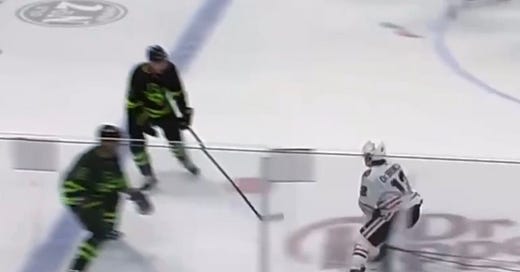Most of us have been around the sport of hockey long enough to have some pet peeves. One thing that has bugged me for a while is when teams don’t take advantage of the rulebook.
This doesn’t mean digging into the fine print and finding loopholes. Moreso, it simply means understanding how to use the basic rules of the game to your advantage. Here are a few quick ways that your team can bend the current rulebook in your favor.
Using The Red-line
Icing is an infraction when a player shoots the puck over the center red-line and the over opposing team's red goal-line, in that order. The whistle blows and the faceoffs occur in the offending team’s defensive zone.
How to use it for a competitive advantage?
Defense should have tight gaps (space between themselves and the attackers) and be able to force a play before the red-line.
Forwards should step up if they have support behind and force players to make a risky play or ice the puck.
Using The Blue-line
Offside is an infraction when an attacking player without the puck enters the offensive zone before the puck enters the offensive zone.
How to use it for a competitive advantage?
Defense should have tight gaps (space between themselves and the forwards) and be able to force a play before the blue-line.
Forwards should step up if they have support behind and force players to make a risky play or dump the puck.
Analytics Importance
Why do players, especially defensemen, give these advantages away for free? It’s a fair question.
You can harp on this all season, and yet players will still forget to gap up and make plays at the red-line and blue-line. When a player does this consistently, it’s something coaches get excited about and evidences their game awareness. It’s a great habit that translates up the highest levels of the sport.
Due to the constraints of the rulebook, these areas on the ice are of high importance. These natural barriers on the ice should be used to great effect. Analytics and hockey people everywhere are tuned into these areas and track them. They know they are critical. In fact, some of the best manual microstats trackers in the sport spend a lot of their time focusing on what happens at each blue line, both for gaining and preventing zone entries.
During the summer of 2013 Eric Tulsky, the Carolina Hurricanes current assistant general manager (former director of analytics), caused a dramatic shift in how the NHL valued controlled zone entries after publishing his paper, “Using Zone Entry Data To Separate Offensive, Neutral, And Defensive Zone Performance.”
Zach Parise and other star players at the time were quoted on how Tulsky’s research changed how they approached the game. We’ve seen a dramatic decline in the dump & chase strategy ever since.
“I read a study this summer that showed shots generated off carrying the puck in as opposed to dumping it in, and it’s like 4-to-1. It’s not even close,” said Parise “I just found it so interesting because everyone’s like, ‘Forecheck, forecheck, forecheck.’
“I get it, but you dump the puck, you have to get it back. All you’re doing is giving the puck away. I mean, it’s so hard to get it, why would you give it away?”
…“But dump it just to dump it, I’m not a believer anymore in getting rid of the puck when it’s so hard to get. That’s the way we played in New Jersey. We always had a plan: Forwards dumped it in, we knew where it was going and that’s how we got it back. But the more I thought about it, possession is just so much better than dumping it in. Dumping it should be, I don’t want to say your last option, but your second or third option.”
Next time you’re watching a game, watch how defending teams do - or don’t - use the defending blue line and red line to their advantage.
Further Reading - Empowering Your Players To Have Long-Lasting Confidence
Did you enjoy this newsletter?
Help us spread the ideas within and share it with the people you care about



